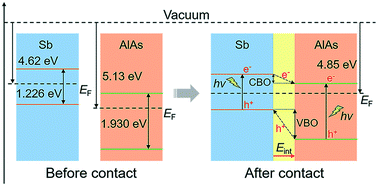A theoretical design of photodetectors based on two-dimensional Sb/AlAs type-II heterostructures†
Abstract
Designing van der Waals' heterostructures with prominent properties is crucial to improve the performance of nanoscale optoelectronic devices. In this article, the structural stability and electronic properties of Sb/AlAs heterostructures were investigated by comprehensive first-principles calculations. It is worth noting that Sb/AlAs heterostructures have good thermal stability and a small lattice mismatch. Owing to suitable direct-gap and intrinsic type-II band alignment, effective separation of photogenerated carriers occurs at the interface, which has numerous optoelectronic properties suitable for use in photodetectors. Furthermore, the heterostructure undergoes transition from indirect-gap to direct-gap under vertical strain. When an external electric field is applied, the charge transfer is significantly enhanced and a semiconductor–metal transition is accomplished. The biaxial strain can induce indirect–direct–indirect transition, and the effective mass of electrons and holes exhibit notable anisotropy, which can be modulated by tensile and compressive strain. The above-mentioned results provide valuable theoretical guidance for designing high-quality Sb-based heterostructures and specify an orientation for high-performance photodetector applications.



 Please wait while we load your content...
Please wait while we load your content...